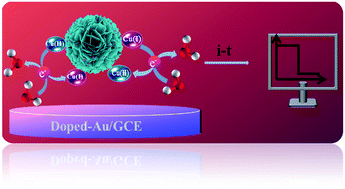Application of a CuS/Au heterostructure with peroxidase-like activity in immunosensors†
Abstract
The early detection of tumour markers is essential for the timely treatment of cancer, and thus realising the sensitive detection of carcinoembryonic antigen (CEA) is significant. Herein, we employed an electrochemical immunosensor as a simple analytical method. The loading of precious metals significantly amplifies the signal of electrochemical immunosensors. In this study, the successful loading of Au NPs was achieved via the galvanic displacement method. Moreover, CuS nanoflowers possessed intrinsic peroxidase-like activity, which could catalyse the oxidation of o-phenylenediamine (OPD) to generate a light-orange product in the presence of hydrogen peroxide (H2O2). The flower-shaped CuS not only provided active sites for the catalytic reaction, but also possessed a large specific surface area, which could provide abundant sites for the placement of Au nanoparticles. Thus, it was suitable for the labelling of Ab2 for the sensitive detection of CEA. The instant current response (i–t) method detected CEA quantitatively, and the immunosensor prepared under the optimized conditions exhibited an excellent analytical performance. The detection range of the sensor prepared in this study was 0.1–80 ng mL−1 and its detection limit was 5.5 pg mL−1 (S/N = 3).



 Please wait while we load your content...
Please wait while we load your content...